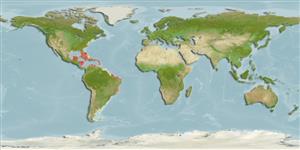>
Ovalentaria/misc (Various families in series Ovalentaria) >
Pomacentridae (Damselfishes) > Microspathodontinae
Etymology: Stegastes: Greek, stegastos, -e, -on = covered (Ref. 45335); fuscus: Named for its type locality, Trindade I..
More on author: Cuvier.
Environment: milieu / climate zone / depth range / distribution range
पारिस्थितिकी
समुद्री प्रवाल-भित्ति संयुक्त; गैर प्रवासी; गहराई सीमा 1 - 15 m (Ref. 40395), usually 1 - 4 m (Ref. 9626). Tropical
Western Atlantic: Brazil. Some authors consider the population in Caribbean Sea as another species, Pomacentrus dorsopunicans (Ref. 9626). Reported in the eastern Atlantic off Senegal (Ref. 10797).
Length at first maturity / आकार / वज़न / Age
Maturity: Lm 7.0 range ? - ? cm
Max length : 12.6 cm TL पुल्लिंग / अलिंग; (Ref. 9626)
पृष्ठीय रीढ़ (सम्पूर्ण): 12; पृष्ठीय सौफट रेज़ (सम्पूर्ण): 15-16; गुदा कांटा 2; ऐनल सौफट रेज़: 13 - 14
Adults inhabit shallow, coral or rocky bottoms and sometimes near the shore in areas with little visibility (Ref. 9626). Juveniles were collected from tide pools and on rocky Lithothamnion reefs; adults found up to 15 m depth (Ref. 40395). A diurnal species, adults feed on benthic algae, polychaetes and harpacticoid copepods (Ref. 9626); also consume hydroids and sponges and has been observed to feed on Abudefduf saxatilis eggs at night (Ref. 9626). 16:21 SL/TL (Ref. 9626). Oviparous, distinct pairing during breeding; eggs are demersal and adhere to the substrate; males guard and aerate the eggs (Ref. 205).
Oviparous, distinct pairing during breeding (Ref. 205). Eggs are demersal and adhere to the substrate (Ref. 205). Males guard and aerate the eggs (Ref. 205).
Allen, G.R., 1991. Damselfishes of the world. Mergus Publishers, Melle, Germany. 271 p. (Ref. 7247)
IUCN Red List Status (Ref. 130435)
Threat to humans
Harmless
Human uses
अधिक जानकारी
संदर्भजलीयकृषिजलीयकृषि रूपरेखाखींचआनुवंशिकीElectrophoresesहैरेटिबिलटीबीमारीप्रक्रमणNutrientsMass conversion
साधन
Special reports
Download XML
इंटरनेट स्रोत
Estimates based on models
Preferred temperature (Ref.
123201): 23.6 - 28.1, mean 27.3 °C (based on 775 cells).
Phylogenetic diversity index (Ref.
82804): PD
50 = 0.5000 [Uniqueness, from 0.5 = low to 2.0 = high].
Bayesian length-weight: a=0.01514 (0.00861 - 0.02661), b=3.03 (2.87 - 3.19), in cm total length, based on LWR estimates for this species & (Sub)family-body (Ref.
93245).
Trophic level (Ref.
69278): 3.3 ±0.23 se; based on food items.
Generation time: 5.8 ( na - na) years. Estimated as median ln(3)/K based on 1
growth studies.
लौटाव (Ref.
120179): माध्यम, न्यूनतम जनसंख्या दुगनी होने का समय 1.4 - 4.4 वर्ष। (Preliminary K or Fecundity.).
Fishing Vulnerability (Ref.
59153): Moderate vulnerability (37 of 100).
Nutrients (Ref.
124155): Calcium = 82.9 [43.6, 138.3] mg/100g; Iron = 0.621 [0.369, 1.032] mg/100g; Protein = 18.7 [17.5, 19.7] %; Omega3 = 0.137 [0.083, 0.226] g/100g; Selenium = 17.8 [9.1, 34.0] μg/100g; VitaminA = 222 [66, 717] μg/100g; Zinc = 1.92 [1.30, 2.68] mg/100g (wet weight);
